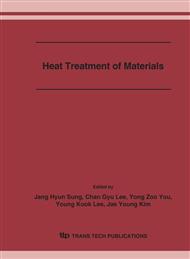p.363
p.369
p.375
p.381
p.387
p.393
p.399
p.405
p.415
A Computational Model for Phase Transformation-Temperature-Distortion Coupling of AISI 5120 Steel
Abstract:
A coupled model for predicting phase transformation, temperature, and distortion of AISI 5120 steel occurring during heat treatment process has been developed. The phase transformation kinetic models were made using Johnson-Mehl-Avrami equation and the additivity rule based on theoretical thermodynamic model and experimental dilatometric data. Especially, the transformation strains measured during cooling were converted to the volume fraction of each phase for the kinetic models using a relation between transformation strain and atomic volume change. The heat transfer coefficients in quench media were calculated by inverse method of the heat transfer equation to the measured surface temperature history. To predict the temperature and distortion accurately, the thermal and mechanical data were used as a function of temperature and each phase based on the experimental data. The coupled model for phase transformation, temperature, and distortion has been implemented in the commercial finite element software ABAQUS as user subroutines. The calculated results by the coupled model were compared with the experimental ones.
Info:
Periodical:
Pages:
387-392
Citation:
Online since:
December 2006
Authors:
Price:
Сopyright:
© 2006 Trans Tech Publications Ltd. All Rights Reserved
Share:
Citation:


